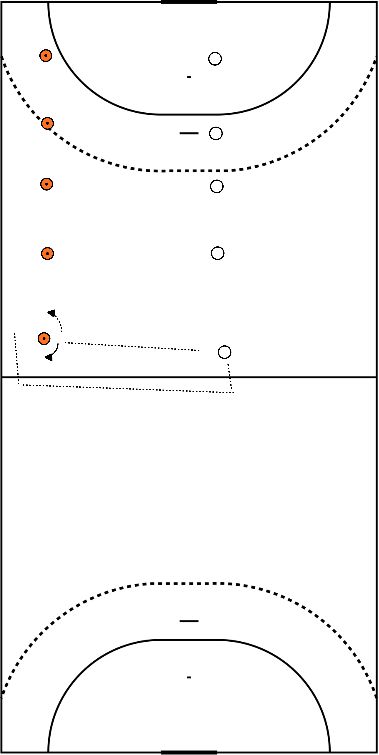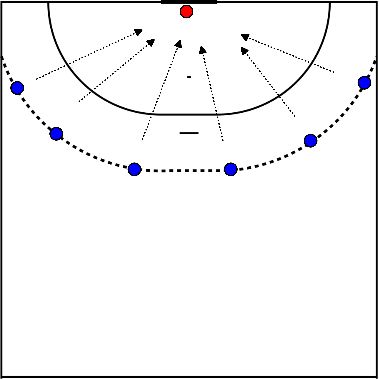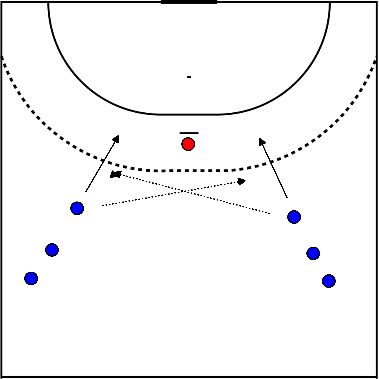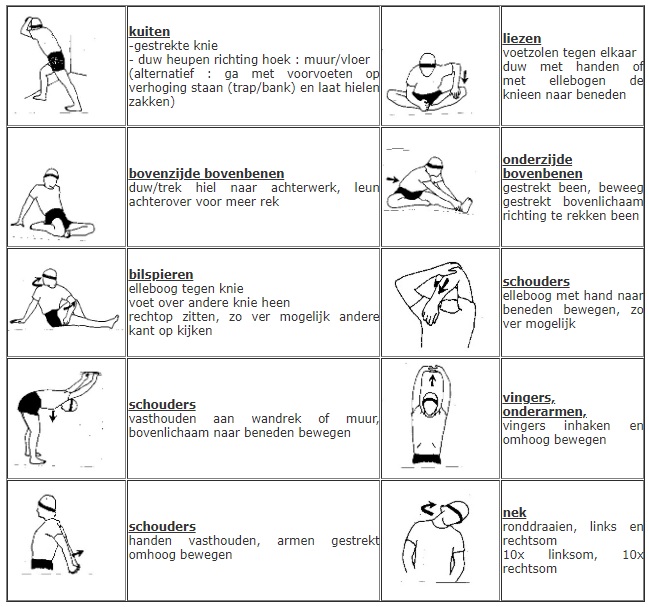Handball drills for technique warming-up
- Dribbling to the pylon
- Passing move.
- Backwards, pass the ball to the next player in line.
- Option:
- Roll the ball and when it's halfway, follow it.
- Pick it up. idem.

- Place a flag in the middle of a circle.
- Provide the circle with pawns spaced every 75-100 cm, depending on the level of the player/players.
- See also:
- Distribute the players around the circle between the cones;
- Start by 'jogging'between the cones (snake movement);
- Arms take turns (warming up)
- At the signal of the trainer ( whistle) short sprint to the flag in the middle and back again;
- 2x whistle sprint to the outside
- Next exercise :
- Zig-Zag (left to right) between the cones,
- Run sideways outside, and make rainbows (knee up) with the left foot over every cone
- Run sideways (inside) and make rainbows (knee up) over each cone (with right foot);
- Short dribble with the feet forwards and backwards between the cones, but keep on turning.
- Goalkeeper in goal
- Players stand on each position on 9 meter line
- Take turns shooting at goal (hands / high / low)

- Goalkeeper stands in the goal
- At 3 meters stands a yoke
- Goalkeeper throws the ball on the tow and catches it himself
- Group in 2 rows (LO and RO)
- 1st LO without ball
- 1st RO plays ball to LO, LO shoots at goal
- 2nd LO plays ball to RO, RO shoots at goal
Also useful to play the goalkeeper:
- On the hands
- Top corner left / right
- Shoulder height left / right
- Knee height left / right
- Bouncing balls left / right
- Low balls left / right

Warm up (feet always moving)
- Throw over short distance
- Throwing over longer distance
- Throwing over half a field
- Running into the bounce
- Push pass
- Keep ball in the middle (high tempo)
- 1-1 push
Run 3x
Arms (exercise to, run back)
- Right arm forward
- Left arm forward
- Right arm backwards
- Left arm backwards
- Two arms forward at the same time
- Two arms in reverse
- Two arms alternately forwards
- Two arms alternately backwards
Legs(outward exercise, return walk)
- Knee lift low
- Lift high
- Heels buttocks
- Left front slide
- Slide pass right front
- Crossover step left front
- Cross pass right front
- Curves
Sprint up and down 2x
Stretch
- Calves
- Hamstrings
- Arms
Circulation warm-up
- This consists of a loose walk-in for 5 to 10 minutes with various light movements for arms, legs and torso.
- By doing this you actively bring the function of the heart, lungs, nervous system and muscular system to a higher level than the resting level.
Stretching

- Start and finish line, caps are scattered around the field.
- The number of caps is the number of players in the team x 2.
- Caps are brought to the end line one by one, the team that finishes first wins.
- There is one scapegoat without the ball and two players without the ball.
- The ball is thrown over in a good position, who has the ball can be tapped without the ball.
- The ball may be held for a maximum of ten seconds.
- If the ticker has intercepted a ball, then that ball goes out of the game.
- Are you tapped you go to the side when no 2 comes on the side does no 1 again.
- Pairs face each other.
- Ball between them.
- Players stand with their hands behind their backs.
- As soon as BAL is called they try to grab the ball as fast as possible.
- Who catches it first, wins.
- From the group, a scapegoat is appointed.
- The game is played all over the field.
- The group is lined up on one side of the field.
- On sign the children cross the field.
- One of the catchers tries to catch as many children crossing the road as possible.
- Variation
- The children walk to and fro on a signal.
- Back and forth without waiting for a signal.
- The children are not free on the other side.
- With two tappers.
- With boxes where there is one ticker in each box.
- The children can be tagged in every cell.
- Who has not been tagged on the way out and on the way back?
- Or which group of tickers has managed to tick the most children?








